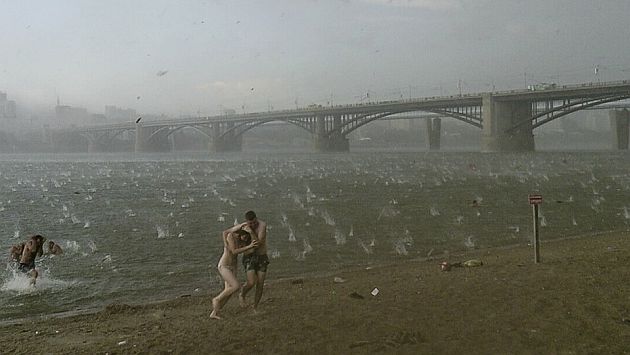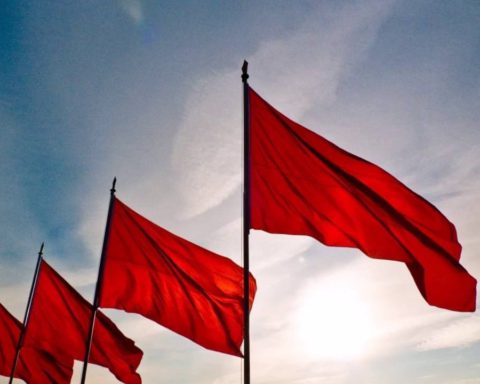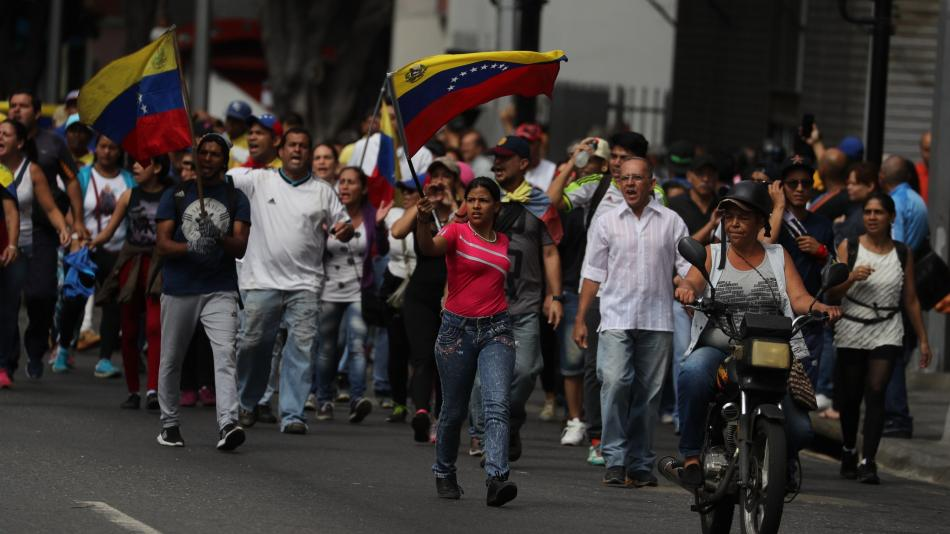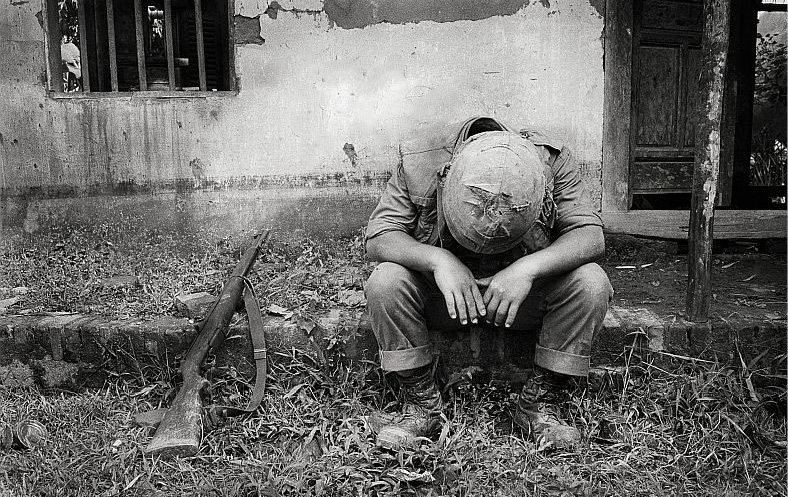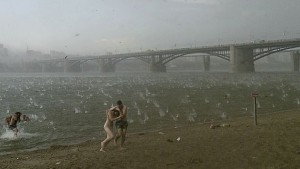 The economic measures taken by Macri appear to break with the kircherist inheritance. Beyond the different social alliances behind each political framework, the measures were not marked by supposedly opposing economic programs (wich are not really that) but by the world economic situation.
The economic measures taken by Macri appear to break with the kircherist inheritance. Beyond the different social alliances behind each political framework, the measures were not marked by supposedly opposing economic programs (wich are not really that) but by the world economic situation.
Damian Bil (OME-CEICS)
The various signs of the international economy since mid-2014 show that trouble like the fall of chinese stock market are not small setbacks without importance as some supposed. On the contrary, like we analyzed in its moment, (1) this works as evidence of the appeareance of the contradictions on which the global economic recovery after the 2008-09 crisis settle down, in one of the promoting countries.
Grim Scenario
In fact, nowadays there is no agreement about the capacity of China to push the rest of the global economy , and about the future state of health of the yankee economy, which held a sustaining although moderate growth since the aforementioned recession. It is true that even today, most international analysts are prone to foresee a minor slowdown of the growth in relation to early years. Others like Roubini, don’t think that the current situation can be compared to the one of 2008 and discard the possibility of China having an emergency landing.(2) However, some international organisms started to modify their growth predictions for 2016 downwards; for the third time in less than a year, in october of 2015 the IMF lowered its prevision from a 3,6% to a 3,4% with extremely low levels for the Euro zone (1,7%) and for Japan (1%). United Nations is even more pessimistic and estimates a 2.9%, wich is little more than half the rate of growth of the world economy before the last crisis. On the other hand, the World Bank warned on halting trade and stagnation of consumption as an indicator of global problems. The Baltic Dry Index, index which measures goods circulation (specially raw materials) on different central sea routes, and that is utilized as a thermometer of the evolution and perspective of the international economy, has lower levels than the ones from 2009. Similar circumstances occur with the chinese index of port cargo, accumulating, since the peak of 2012 through january of 2016, a drop that surpass the 40%.
All of this adds to the end of the “tailwind” of the emergent economies, because of the drop on the prices of the commodities linked to a lesser globald demand, specially from China, and a revaluation of the dollar.(3) And this tends to go on: according to the World Bank, in 2016 the non-energetic goods will drop a 3,7%, metals a 10%( after collapsing a 21% in 2015) and agricultural products a 1,4%.
Petroleum, indebtedness and Stock Market
The case of petroleum is the most significative due to the scale of the fall, ascribed to the lesser world demand,a consequence of the stagnation of Europe, Japan and China, and because of the growing production which comes as a result of the ongoing “war of prices” between Arabia and its partners, against the non-conventional exploitation from USA and other countries. To this scenario we have to add the return of Iran to the world market. As a result, the OPEC basket price went from 60 dollars in july of 2015 to a bottom of 25 for January 13 of this year with a diary overproduction of 1,5 million barrels. For this reason, it is estimated that during 2015 exploitation projects worth 350 million dollars throughout the world were suspended. The nine biggest oil companies of Europe accumulate losts for about 250 thousand million euros since mid 2014, when the sharpest fall of the price started.(4)This fall wasn’t reflected on an economic recovery through a shock of cheap energy. On the contrary, the situation affected countries that depend on oil and raw materials like Russia, Venezuela, Nigeria or Brazil; and threatens to extend to Turkey and South Africa. The most affected are the ones with a high private credit / GDP, where the loans are in risk of not being paid (specially by companies from the raw materials sector), and countries which took debt in dollars.
The symptoms of a contraction were seen on the market movements during the last months of 2015 and the first weeks of this year. Unlike other episodes, in this occasion the fall of the price of the crude oil and the values of the stock market around the world marched in unison. All the relevant indexes (Dow Jones and the S&P500 from USA, MSCI, the FTSE from London, the ones from China, among others) show since mid 2015 a downward trend, with harsh losses in the case of China.
By themselves this phenomena are not necessarily denoting a recessive perspective. But there are other conditions that add fuel to the fire on the problems of accumulation. One of these is that the crisis assumed a state nature, This is: the exit to the 2008-2009 crisis was related to the intervention from the governments expanding the monetary supply using different ways and incrementing the volume of fictional capital. The Federal Reserve decided to stimulate through the injection of resources and lowering the rates of interest to a level near zero, together with the purchase of bond and other actives, something that the European and England’s Central Banks also did. This policy was name “Quantitave Easing” in USA, and postponed a bigger bang, but with a cost, inflating the commodities bubble, due to the inversionits looking for bigger befenit actives than the bonds of the Treasure and miggrating to emergent countries titles and energetic companies actions. At the same time, the public indebtedness saw a growth. The central banks of the G-20 pushed, since the last crisis, infrastructure projects and productivity improvements for 2 thousand billion dollars, without much return. In this cirumstances the “liquidity trap”, wich looked like something exclusively from Japan, seems to affect other economical potences. Even european countries and Japan itself went from zero rate to negative rates policies. Again with no actual results to re-launch the accumulation.
The emergent countries have multiplied their tax deficit and their public debts, with scarse or strictly non-existant benefits. During the last months, the cycle reverted: the rentability in these countries eroded and started to appear negative fluxes on capital income. Ultimately, the different monetary authorities have no margin to continue using that strategy in a context where the rates are falling down. The attempt of the FED to rise them in a proggresive way until they reach a 1,375% in december of 2016 just caused a bigger fall in actions and Treasure bonds; while a revaluated dollar affects the exportations and profit from North American corporations.
The growth of the commodities bubble and the expansive policies to escape the crisis from 2008 2009 couldn’t avoid that, less than a decade later, the capital lead the world to a new capsizing situation, which has already untied with fierce in the fields where the economical potencies dispute the markets. All eyes are watching the main economies health: United States and China.
USA… Will it stop?
The momentary way out for the 2009 crisis of the USA was given through the means of the monetary expansion way with the biggest incentive program in the history of the country. To understand the size of the money pumping in all its shapes (circulating, loans to financial entities, long term Treasure purchases, bonds, etc.) by the Federal Reserve, until october of 2014 it dumped a value of 3,5 trillion dollars. This is to say, the equivalent to the Germany’s year GDP, Between this measures, the FED conducted a bond purchase policy to mantain low rates on a long term.(5) In the next years to the crisis, the recipe seemed to work. For this reason, many burgeois economists singed eulogies to the american recovery, that if not spectacular, mantained a slow but sure pace of the anual 2,5%. In a China’s slowdown context, the chronic stagnation from Japan and the Europe problems, these rates were not something to worry about. At the same time, the employment recovered, but with stagnated real salaries since 2008 and the homes debts were reduced.
However the foundations of this process were weak.(6) During the last months some evidence that the problems weren’t solved appeared. On one hand, the industrial production had a setback of an interannual 2% in December. This drop was motorized basically by the oil sector, specially for the blow suffered beacause of the investments made on non-conventional resources (shale and tight oil) due to the drop on the international price, which lead to a contraction of the 10% in the mining chapter. Among other sectors the consumption came to an halt in spite of the incentives, like automobiles (-0,9%) or durable goods, which had the major drop in sales since recession (-3,5%). During 2015, with a rising dollar, the exportations diminished, which stopped the increase since 2011. Aditionally, the investments didn’t grow the way they were expected to with the expansive policy of the Federal Reserve, and the rise of productivity was brief. But the fundamental point are profits, the system’s engine. On this item, the mass of profits of the corporations was also reduced, for over 5% between 2014 and 2015. The JP Morgan predicted a fall of 10% on this year profits, the posibility of this happening in the United States is located in the order of 25%, the highest risk of the last five years (the Citibank says it is in the order of 65%).
That is to say, that there are elements that in another historical times preceded a recession.(7) The FED policies were good enough for this only. This means a situation not unlike the one before the crisis. If for any reason a recession was avoided (or postponed), the best case scenario will be a term of stagnation or very low growth.
A dragon too heavy
The asian giant registers, since more than a year ago, symptoms of decelaration. Some analysts point out that this is due to a change of the chinese “development model”, which could be found in the transition between an outward-growth oriented structure via exportations and cheap salaries, and a more domestic-growth oriented strategy with credit incentives and wage rising measures. As we mention in this pages (see note 1), actually this situation expresses the arrival of the Crisis to China. Farm from an ordered transition between two schemas which can be replaced mutually, the phenomena observed is the desperate try of the authorities to cover the sun with their hands.
The chinese economy shows alarming numbers: the GDP growth is slowing down at rates that are the lowest in the last 25 years. Similar phenomena occurs with the industrial activity, the investment and foreign trade. The profits fell down in nominal terms during 2015 for around an interannual 3%,driven by the sectors linked to construction and industrial supplies.(8) The exportations also suffered a slow but continuous deterioration. Is this deceleration which took the chinese authorities to intervene so the activity could be sustained, rising the public debt from 7,4 billions to 28,2 billions in less than seven years (since 2007 until mid-2014). The incentive was directed towards construction with credits and to general consumption. In this opportunity little savers and homes were motivated to invest, diminishing the minimum legal reserve. The market movement multiplied in an exponential way with loans of the so called “shadow market”, a paralell system that moves 3,5 billion dollars. While the economy stagnated, the Stock Exchanged grew an annual 150%. By the end of 2014, the People’s Bank of China encouraged this mechanism increasing the emission and reducing the interest rates.(9) This only fed the construction bubble, which left as a result various ghost cities and lots of unsold properties through different regions, that will take no less than five years to purge.
During the beggining of 2016, with a proggresive yuan devaluation going on, the investors went to sell them, provoking its lower level in five years and forcing the People’s Bank of China to intervene so it could avoid a bigger fall. It’s important to say that during december 108 thousand million dollars of reserves were used to contain the market price. The monetary authority looks trapped in this: on one side, the efforst to sustain the yuan and to restrict the operations with other foreign currencies causes the flight to other assets or to other countries, pressing downwards. But to let it fall freely will worsen the “war of foreign currency” and commercial with the USA. Meanwhile about 680 million dollars abandoned China in 2015, more than Argentina’s GDP; and this meant a 90% of the capitals abandoning the emergent economies that year. To this credi slowed down and restrictions for the stock exchange increased. The fall of shares puts the bank system in front of a possible collapse due to the massive insolvency of the debtors.(10)
The decceleration had an impact on the domestic market. The electronic, textile and furnitures sector complained because of the drop on orders and delays of payments. The consumables and heavy industries like cement, steel and glass have idle capacity in alarming levels. The steel industry retracted for 2,3%, biggest drop in 25 years. Chinese industrial of this sector declared losses for 9,8 thousand million dollars in 2015. The “Manufacturing Purchasing Manager Index”, an indicator based on purchases made to representative companies, is located since august of 2015 under the 50 points. This is what is taken in account to distinguish an expansive situation from a contraction.
In short, China is debated by the contradictiones generated by its own weight. This means that the expansion of fictious capital in relation to the exhaustion of the force of the low salaries, starts to hit a narrow base. The fall of the Stock market is not the cause of the problem but the expression of this reality. The additional inconvenient is that China will drag others. Shrinkage in demand for raw materials hit Australia, Brazil, Canada, Chile, Peru and some asian countries. Also Honk Kong, South Korea, Malaysia, Singapore and Tai-Wan, just to mention the more affected ones.
And home…
The economical measures taken by Macri pretend to break with the kirchnerist inheritance, derogation of deductions, devaluation, rise on services rates, as the most relevant ones. Meanwhile there are advancements in an agreement with the vulture funds. Beyond the different social alliances behind every political framework, these measures were not signed by supposedly opposing economical programs (which are not), but for the world economy. This is to say that we observe the transition from a plan based on high international prices of agricultural good to another marked by indebtedness and with a limited weight of the differential farm income. Something similar to what happened in the 90’s. This was the strategy of every fraction of the bourgeosie; including the outgoing government, even in spite of the obstacles Griesa put on their way. Today this becomes the main tool, along with the attack to the living conditions of the working class, to sustain the acumulation against the falling income. If the negotiations are succesfull and the government gets fresh dollars, it could postpone an outbreak for some years and consolidate its place in power, even though in the long term there would be no changes in the economical and social structures of Argentina. A perspective tied to a convoluted global economy, an economy with no other way of solving its contradictions under this regime than with the destruction of an enormous quantity of surplus capital to reactivate the acumulation. This is what capitalist competence will lead us to if there is no answer from the exploited.
Notas
1Magro, Bruno: “Final burbujeante”, in El Aromo n° 85, 2015.
2CNBC, 19/1/16; http://goo.gl/GGaW0L; El Comercio (Lima), 20/1/16; http://goo.gl/GKXsfd.
3In base to W.S.J. Americas (quoted in La Nación), 1/10/15, http://goo.gl/AiGxIN; Libremercado, 21/1/16, http://goo.gl/zI8PPp; The Huffington Post, 25/1/16, http://goo.gl/DIvils; Business Day, 27/1/16, http://goo.gl/gou9p1; Bloomberg, 28/1/16, http://goo.gl/TxFWcU. Para consultar los informes de los organismos: Banco Mundial, 26/1/16, http://goo.gl/eyJoVM; Citibank: G10 Rates Outlook 2016, diciembre de 2015; ONU: World Economic Situation Prospects, 2016.
4El Mundo, 27/1/16, http://goo.gl/nCv9qw.
5Federal Reserve System EEUU and Bloomberg, 16/9/15; http://goo.gl/deqAjM.
6See the analysis of Osvaldo Regina in El Aromo n° 49, 73 y 78, www.razonyrevolucion.org
7Production made with avalaible data from B.E.A. The Economist, 29/01/16, en http://goo.gl/62tW9V; y en https://goo.gl/BnZGlE.
8WSWS, 19/2/16, https://goo.gl/1dD0xK.
9Clarín, 8/1/16, http://goo.gl/F4iH8g; W.S.J. Americas (quoted in La Nación), 8/1/16; http://goo.gl/M4bEyS.
10Clarín, 8/1/16, http://goo.gl/2tl3x9; and The Guardian, 17/1/16, http://goo.gl/VleHbB.

